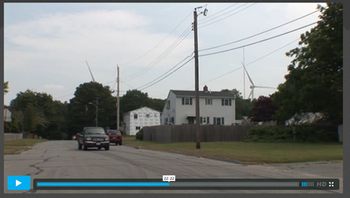Film features the stories of Fairhaven wind farm neighbors
Health, Human impacts, Wind turbines Add comments A new film from Fairhaven, MA, features the compelling real-life experiences of several local residents who live close enough to the wind turbines to hear them on a regular basis. The film, entitled Too Close, has a calm and caring tone, and is free of side-issues that can at times clutter the wind turbine siting debate (e.g., economic or carbon-reduction arguments), and focuses nearly solely on audible noise, with only a brief mention of infrasound. Also, refreshingly, quality of life (including sleep disruption and intrusion in backyard solitude) is given as much or more attention as more acute health effects, and the film is free of the more alarming/alarmist claims that are featured in some other concerned citizen documents.
A new film from Fairhaven, MA, features the compelling real-life experiences of several local residents who live close enough to the wind turbines to hear them on a regular basis. The film, entitled Too Close, has a calm and caring tone, and is free of side-issues that can at times clutter the wind turbine siting debate (e.g., economic or carbon-reduction arguments), and focuses nearly solely on audible noise, with only a brief mention of infrasound. Also, refreshingly, quality of life (including sleep disruption and intrusion in backyard solitude) is given as much or more attention as more acute health effects, and the film is free of the more alarming/alarmist claims that are featured in some other concerned citizen documents.
The 44-minute film can be viewed here.
There are just a couple of things I would add for context, which may be useful as you consider these stories from a range of “regular” people dealing with this new noise in their local soundscape. First, though it’s mentioned in passing a couple of times, some of the issues, especially shadow flicker, but also noise for some more distant residents, are more problematic at particular times of year. For the closest residents, it can be daily or near-daily, while at other places, the problems may at times recede from the intensities described here. When interviewees speak of things that happen “sometimes” or “some days”, it’s not always clear how commonly (how many days a month, hours a day, or months of the year) these experiences occur.
Also, as in every town with noise issues, these hardest-hit residents are a minority of nearby residents. Surprisingly, few solid surveys exist to help us get a better sense of the proportion more severely affected, but some numbers from Fairhaven offer a sense of it. There are just over 700 homes within 3000 feet, and residents of at least 56 of these have filed formal complaints; that would represent about 8% of homes, a small proportion, but a significant breadth of impact. In this video, all or nearly all of the residents live significantly closer (950-2100ft); it’s quite likely that most of the complaints come from this closer zone, and that somewhere between 10-20% of closer homes have complained. Also, we need to bear in mind that not everyone is comfortable publicly complaining; doubtlessly, more than 56 homes are experiencing issues similar to those discussed here.
A valid question can be raised about how high a proportion of negative impact is acceptable around any new infrastructure or industrial development. Some will surely argue it’s reasonable to expect to impact 5-10% (or even 20%) of nearby residents, while providing social benefits for many more. Yet, in a small town, when over 50 families are having their lives disrupted, it can cause a serious rupture in the local social environment; this “tearing the community apart” effect has been stressed in many other locales where noise became an issue. As reasonable as it may be to suggest that “you can’t please everyone,” it’s also entirely valid for towns to consider the effects on their sense of local community if dozens of homeowners were to become aggrieved at a proposed new development.
All in all, this film provides a credible and compassionate look at the personal side of an issue that is often swept up into polarizing hyperbole and self-serving rhetoric from both sides.
